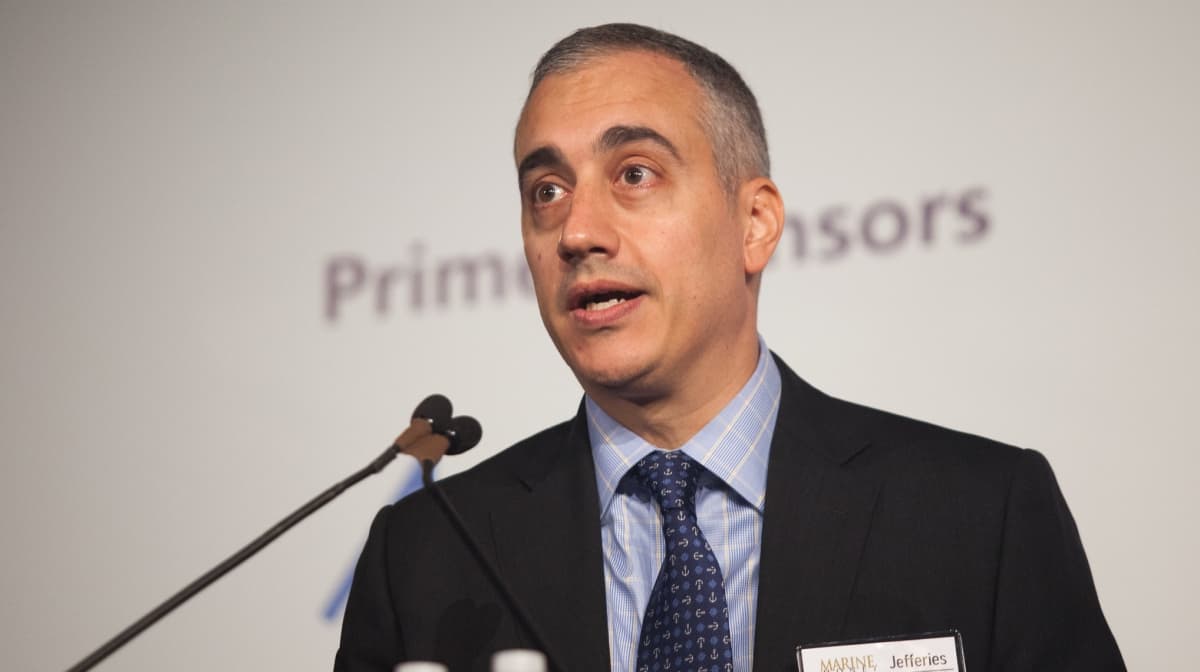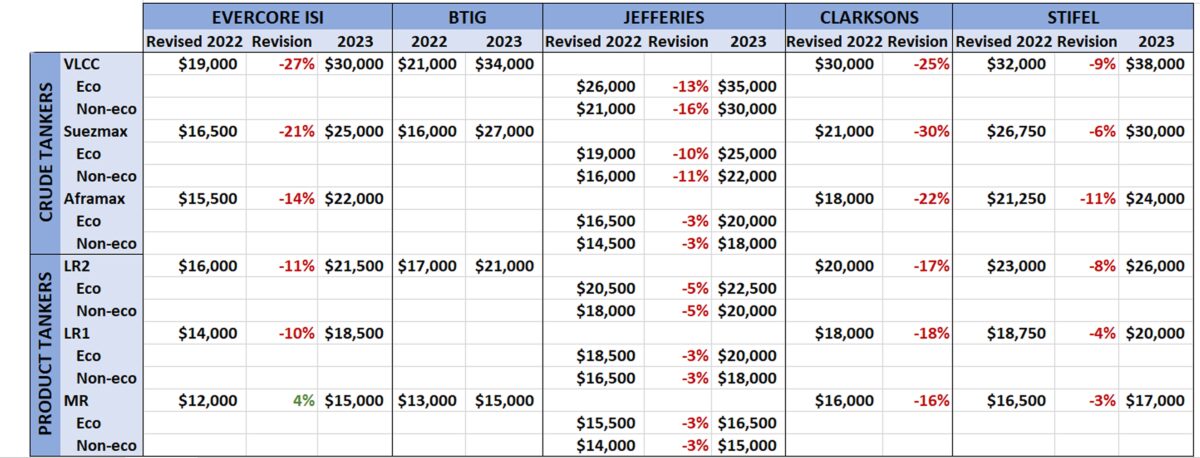The outlook for tanker rates was already dicey. After the worst year in three decades in 2021 and a terrible start to 2022, analysts have just cut their rate forecasts and pushed back their recovery timelines, yet again.
As one tanker owner told brokerage Fearnleys, “The light at the end of the tunnel has been visible for quite some time, but right now it feels more like that’s a truck coming toward you.”
Jefferies
Jefferies analyst Randy Giveans cut his tanker rate estimates on Wednesday, the latest in a string of analyst pullbacks (see chart below for data on all analyst revisions).
“The expected tanker market recovery has been delayed by the spread of omicron,” said Giveans. He reduced his 2022 forecast for non-eco (i.e., older) very large crude carriers (VLCCs, tankers that carry 2 million barrels of crude) by 16% to $21,000 per day, and his 2022 forecast for non-eco Suezmaxes (capacity: 1 million barrels) by 11% to $16,000.
On the product tanker side, said Giveans, “We believe a recovery is indeed underway, though moving at a slower pace than previously expected.” He trimmed his full-year 2022 rate forecast for non-eco LR2s (tankers with capacity of 80,000-119,999 deadweight tons or DWT) by 5% to $18,000 per day and reduced his estimate for smaller non-eco MRs (25,000-54,999 DWT) by 3% to $14,000.
Evercore ISI
Of all the analysts, Evercore ISI’s Jon Chappell is the most bearish on 2022 and 2023 tanker rates. Chappell announced significant reductions to his rate forecasts on Monday.
Chappell cut his 2022 VLCC rate estimate by 27% to $19,000 per day, his Suezmax estimate by 21% to $16,500 and his Aframax (750,000-barrel capacity) forecast by 14% to $15,500. He reduced his rate forecasts for larger product tankers by double digits as well: LR2 estimates for this year fell by 11% to $16,000 per day and estimates for LR1s (55,000-79,999 DWT) by 10% to $14,000.

Nevertheless, Chappell stuck to his thesis that the market will turn positive. “We believe in the fundamentals, even if timing is becoming increasingly difficult to pinpoint,” he said, although he acknowledged that “new variants, OPEC restraint and a refusal to scrap [older tonnage] could prolong this painful trough and begin to threaten even the best balance sheets, lending credence to the perpetual skeptics.”
Chappell believes the best stock-picking strategy is “adding exposure to those tanker stocks with material upside and nothing remotely close to liquidity risk,” such as Euronav (NYSE: EURN), Teekay Tankers (NYSE: TNK), DHT (NYSE: DHT), and Ardmore Shipping (NYSE: ASC).
Then, once “the worst-case scenario is off the table,” there could be even more upside from tanker names with both high financial and operating leverage, such as Frontline (NYSE: FRO) and Scorpio Tankers (NYSE: STNG).
Clarksons Platou Securities
Chappell’s tanker rate estimates remain the lowest, yet the largest downward revisions in 2022 forecasts were made by Clarksons Platou Securities.
Clarksons announced its revisions on Jan. 14. It cut its rate forecast for VLCCs by 25% to $30,000 per day, for Suezmaxes by 30% to $21,000, and Aframaxes by 22% to $18,000. There were more big cuts on the product tanker side: LR2s by 17% to $20,000 a day, LR1s by 18% to $18,000 and MRs by 16% to $16,000.
Announcing rate revisions, Clarksons analysts Frode Mørkedal and Omar Nokta wrote: “Tankers are coming off one of the most difficult periods in their history as rates across all segments averaged below breakeven during 2021. The gradual return of the remaining 4 million barrels per day of OPEC+ crude production over the next nine months is expected to lead to much tighter supply/demand dynamics and firmer rates. However, in the interim the sector continues to suffer from too much slack capacity.”
Stifel
Among the analyst crowd, Stifel’s Ben Nolan is currently the most upbeat on tanker prospects. During a panel discussion presented by Capital Link last week, he said, “If there’s any one category of shipping that has the most potential for upside, it’s the tanker market.”

And yet, on Monday, he too lowered his rate outlooks for 2022: for VLCCs by 9%, Suezmaxes 6%, Aframaxes 11%, LR2s 8%, LR1s 4% and MRs 3%.
Even with those revisions, Nolan’s estimates remain far above those of Evercore ISI’s Chappell. Nolan’s VLCC rate forecast for this year, reduced to $32,000 per day, is still 68% higher than Chappell’s.
According to Nolan, “While global oil consumption is recovering, it has not recovered fast enough to support tanker rates. By Q3 2022, global oil demand should reach pre-COVID demand levels, at which point we expect tanker supply and demand to shift back toward a balanced market. In the near term, there could be some product tanker outperformance thanks to new export-oriented refineries and low global inventory levels.
“With respect to equities, we believe this is an attractive entry point near the end of a cyclical trough.
“While highly leveraged names could have substantial upside potential if a recovery happens sooner rather than later, those names also have more risk of dilution in the event of a slower recovery. Our favorite ideas are those names with really strong balance sheets such as DHT and International Seaways [NYSE: INSW], which have some upside exposure with limited risk of dilution or downside.”
BTIG
With 2022 tanker rates worse than expected and recovery expectations pushed back, is it too soon to buy tanker stocks? Chappell acknowledged this point, noting the “brutal start to 2022 for tanker equities” and telling investors: “If you want to wait until rates are already off to the races, we don’t blame you.”
BTIG analyst Gregory Lewis raised questions about buying tanker stocks in an outlook released on Tuesday. He noted that “2022 has started out with a whimper … and while there continue to be signs pointing to a crude tanker market recovery, those same signs were in place this time last year.”
Lewis estimates that rates this year for VLCCs will average $21,000 per day, with Suezmaxes at $16,000, LR2s at $17,000 and MRs at $13,000.
He characterized this year as something of a non-event. “With the winter market winding down, that probably means the VLCC market has to wait until next winter before there is any meaningful pickup in tanker rates. Yes, rates could double for scrubber-fitted VLCCs, but even that move — which is already expected based on 2022 full-year consensus estimates — would have nil impact on most companies’ ability to increase dividends.
“We expect VLCC tanker stocks to continue to lag broader energy [stocks] in the near term and remain defensive,” said Lewis.
“Bottom line: We expect 2022 to be another transition year for crude tanker rates barring a more rapid expansion of global oil production.”

Click for more articles by Greg Miller
Related articles:
- How Russian invasion of Ukraine could impact ocean shipping
- ‘Tricky time’ for shipping stocks: Course corrections ahead?
- Tanker, bulker, LNG rates drop. Container rates hold near top
- As liner stocks keep rising, other shipping shares are stalling
- Omicron threatens tankers but could extend container shipping boom
- COVID-era shipping stocks: The (super) good, the bad and the ugly







